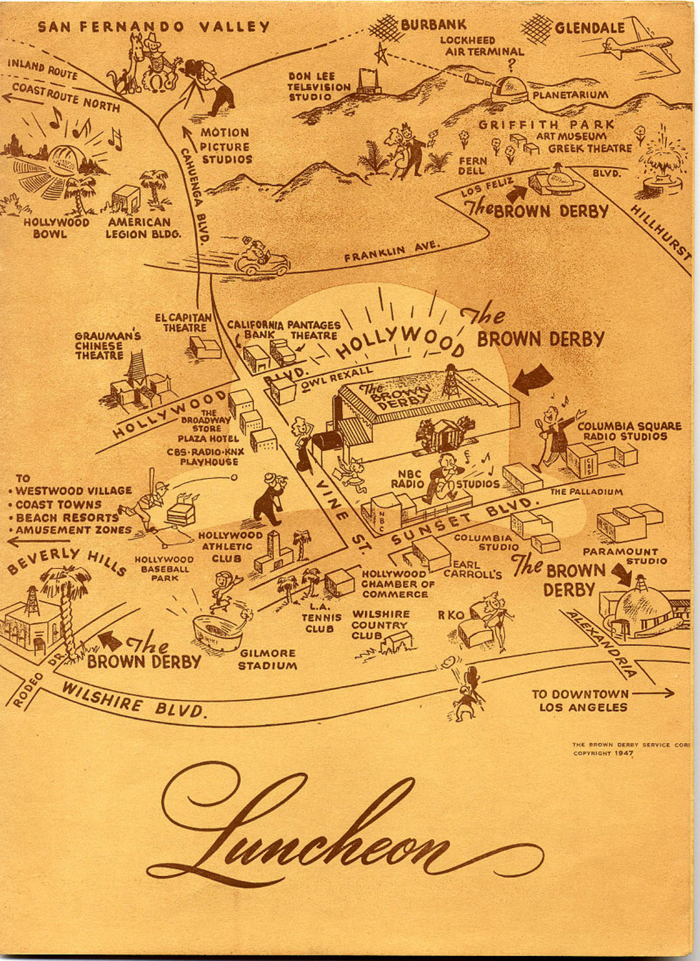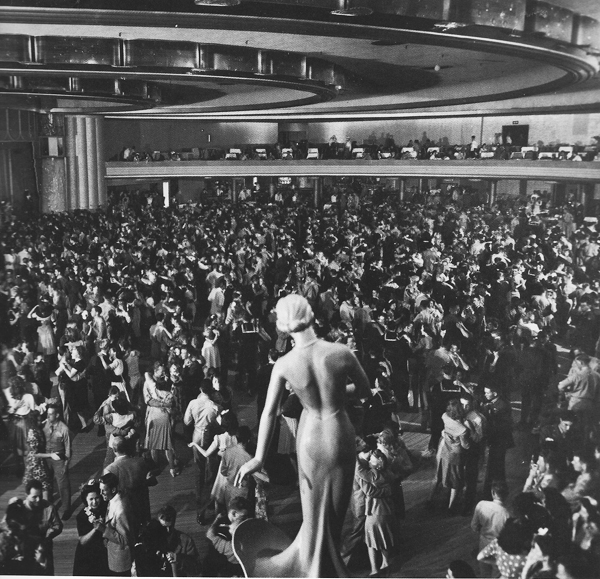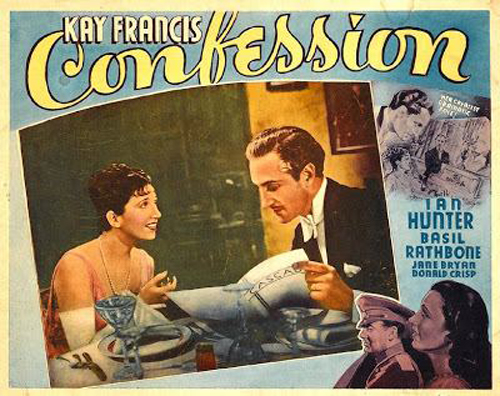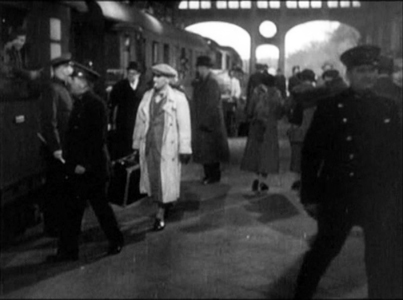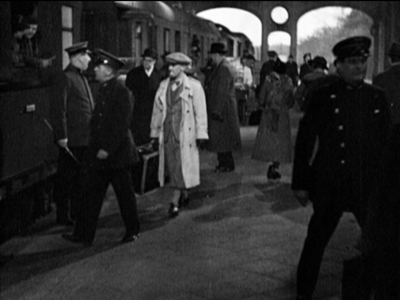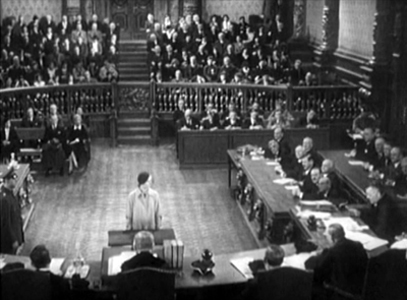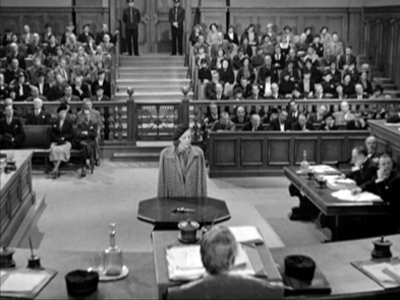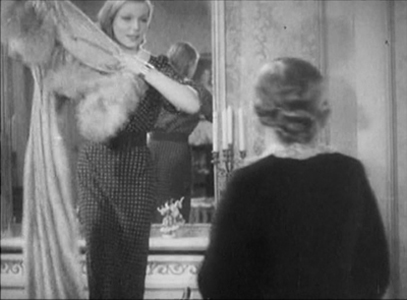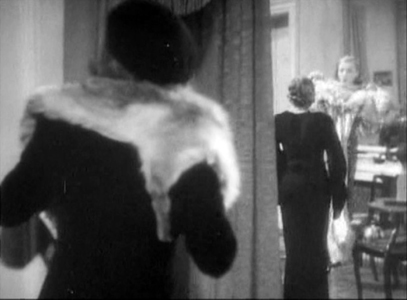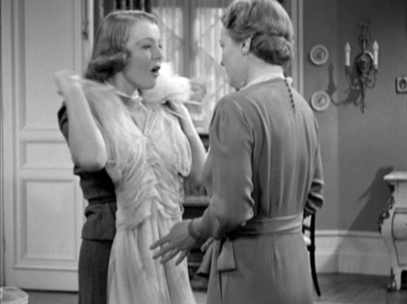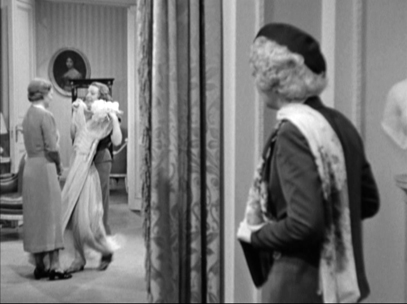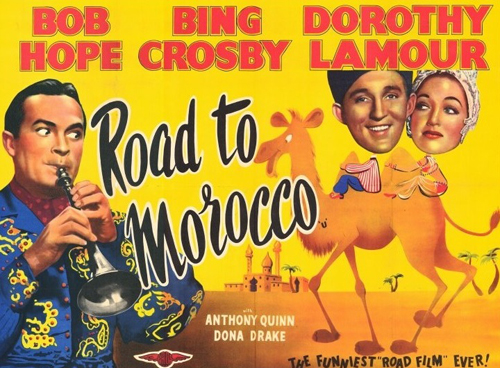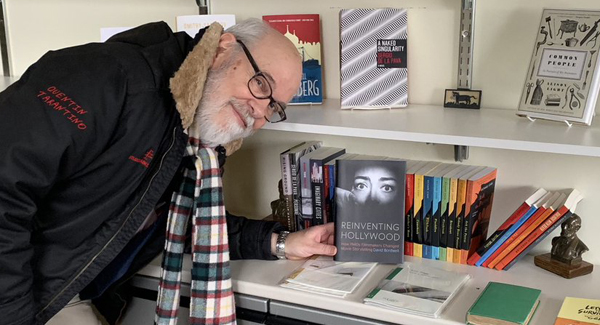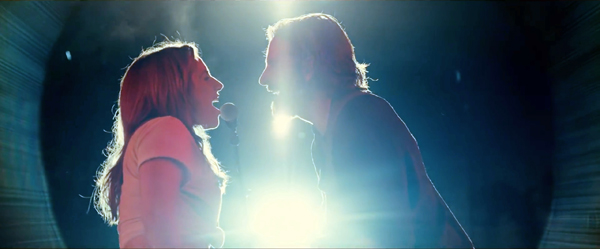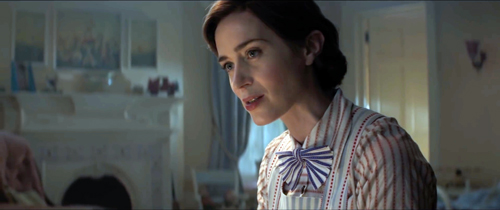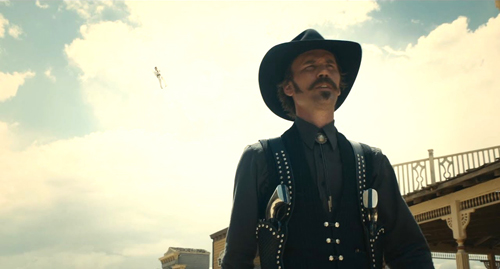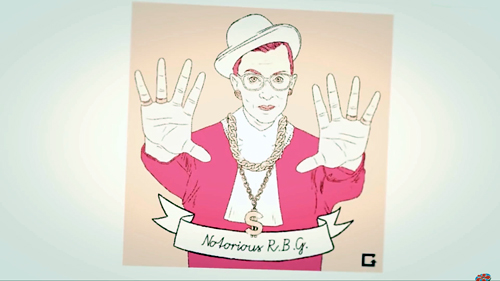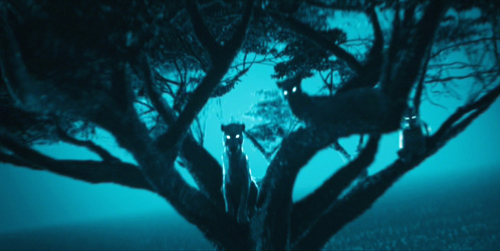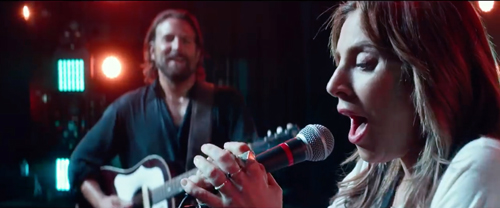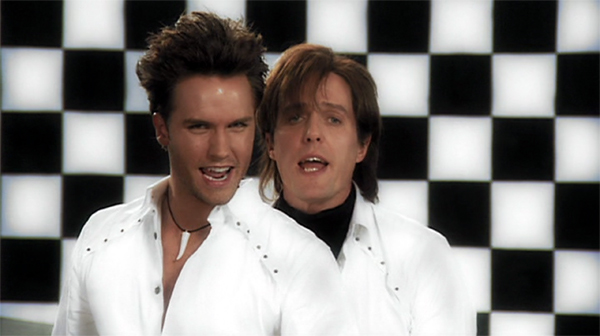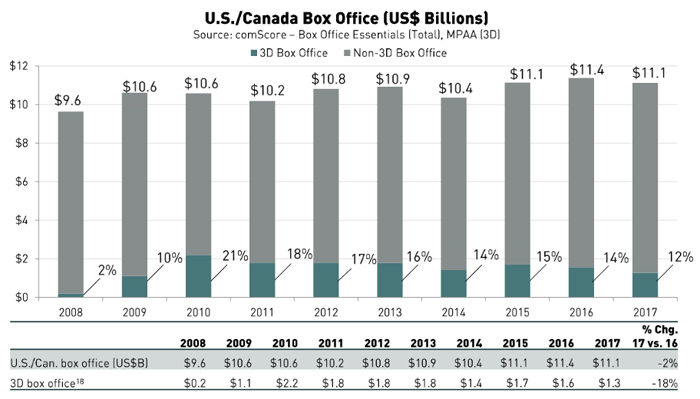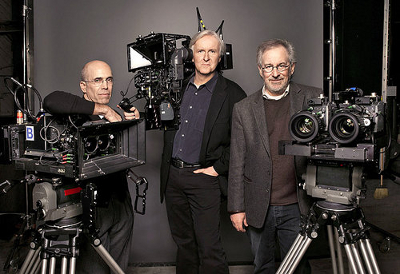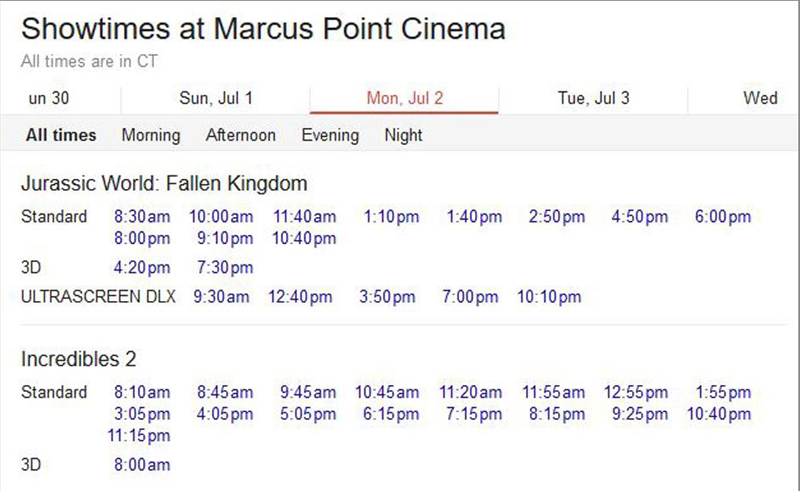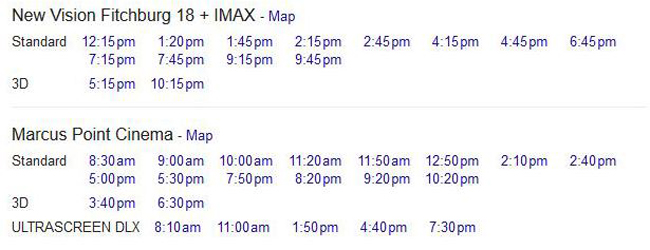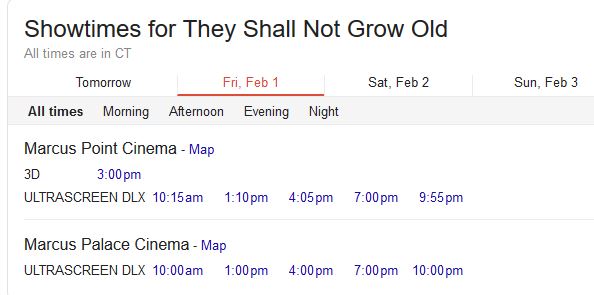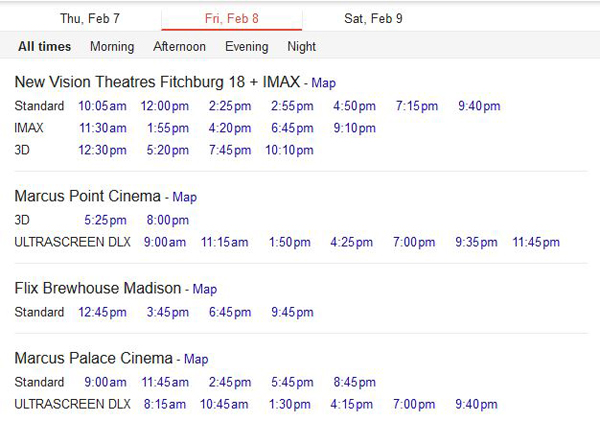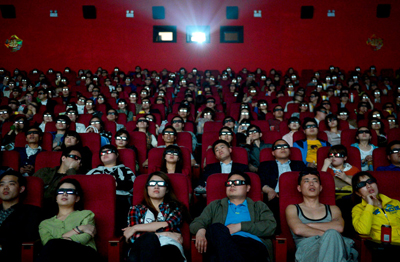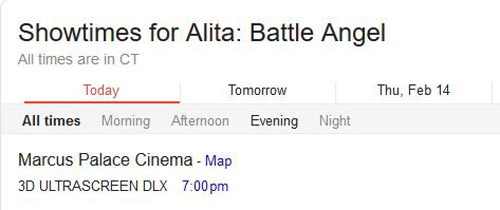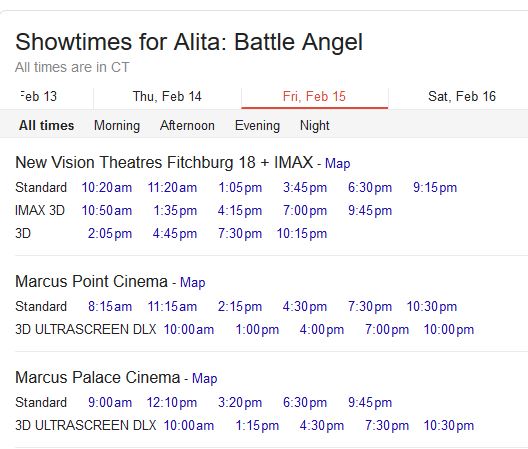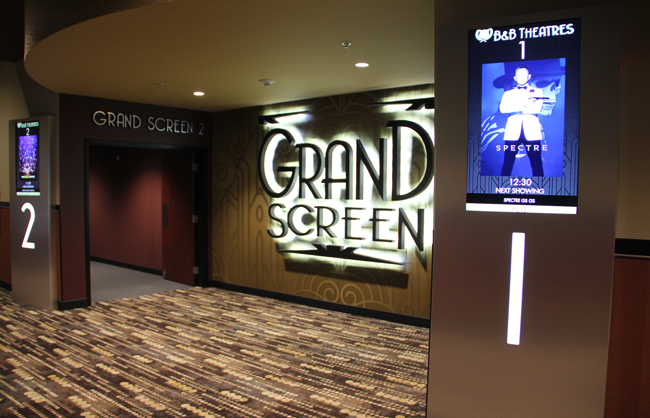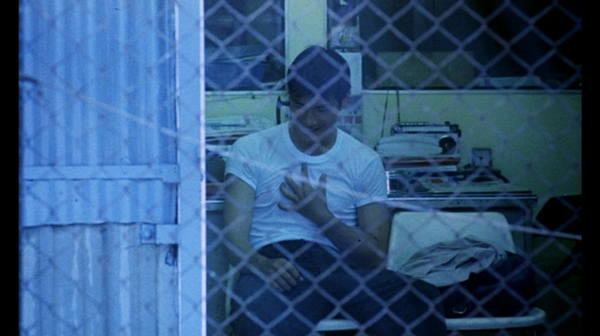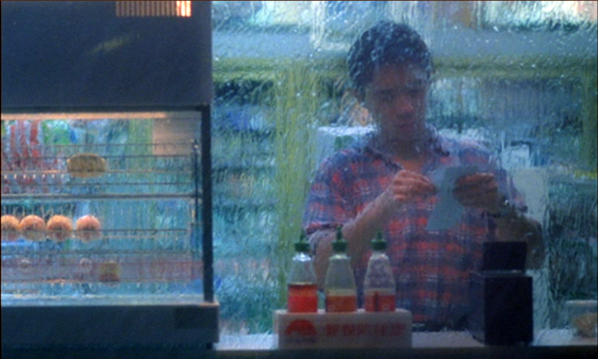Archive for February 2019
REINVENTING HOLLYWOOD in paperback: Extra-credit reading and viewing
Brown Derby lunch menu.
DB here:
Reinventing Hollywood: How 1940s Filmmakers Changed Movie Storytelling came out about eighteen months ago in hardcover. Amazon and other sellers have been offering it at robust discounts. Now there’s a paperback, priced at $30, though that could also be discounted at some point. I hope these options put it within the range of readers interested in the period, in Hollywood generally, and in the history of storytelling in commercial cinema.
But of course time doesn’t stand still. Since I turned in the manuscript around Labor Day 2016 I’ve encountered some intriguing things that were more or less relevant to my research questions. (I’ve also found a few errors, most of them corrected in the paperback edition. Meet me in the codicil if you’re curious.) In this blog entry and some followups, I’ll discuss some films, books, and DVD releases that came out after I finished the book. They don’t force me to change my case, I think, but they’re things I wish I could have cited, if only in endnotes.
Prosperity helps the movies
Lobby, Loew’s theatre, Rochester, New York, 1940.
Apart from studies of single creators, film historians have often sought to go macro, to tie the films to a broader cultural context. Elsewhere on this site I’ve criticized claims that films directly reflect national character, a zeitgeist, or a mood of the moment. There’s no denying that films bear the traces of the societies that make them. The question is how to understand that process—and how to explain it.
I vote for seeing cultural material as filtered through the constraints and choices of the institutions that filmmakers work in. Writers, directors, producers, and other participants (deliberately or unwittingly) pick out bits of cultural flotsam and reshape them. Buzzy ideas become plot premises. New technologies fulfill old functions. The newspaper-headline montages of the 1930s are replaced by shots of chyrons and cable news feeds today. Stereotypes become characters–sometimes unstereotypical ones. Not reflection, then, but refraction, with agents and social institutions recasting some trends that are out there.
But the macro level shapes cinema in another way: as a set of economic and technological preconditions. Around 1900, a society without a market economy and access to machine technology couldn’t have invented cinema. Before the smartphone, people living in certain countries lacked the infrastructure to access the Internet.
Historians sometimes distinguish between proximate causes—factors we can trace with some specificity—and distal causes, those more basic and pervasive preconditions that provide a background for the proximate causes. Along these lines, I wish I’d drawn on Robert J. Gordon’s 2016 masterwork, The Rise and Fall of American Growth.
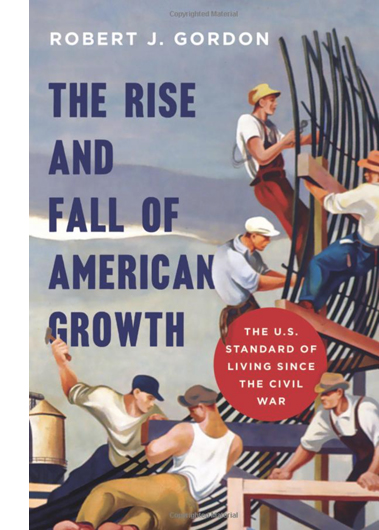 Gordon proposes that the century from 1870 to 1970 saw five great clusters of technological innovations: electricity, urban sanitation, chemicals and pharmaceuticals, the internal combustion engine, and modern communication systems. Most became feasible at the end of the nineteenth century, but they took some years to develop, starting to disseminate through the US population from 1920 onward. They peaked, he claims, by 1970 but a significant threshold was crossed around 1940.
Gordon proposes that the century from 1870 to 1970 saw five great clusters of technological innovations: electricity, urban sanitation, chemicals and pharmaceuticals, the internal combustion engine, and modern communication systems. Most became feasible at the end of the nineteenth century, but they took some years to develop, starting to disseminate through the US population from 1920 onward. They peaked, he claims, by 1970 but a significant threshold was crossed around 1940.
Thanks to the Great Depression, FDR’s recovery scheme, and the start of World War II, both the American economy and most American lifestyles improved dramatically. Home electricity, refrigerators, washing machines, radios, telephones, central heating, cheap clothing, sanitation (no more horse droppings on Main Street), the rise of life expectancy, and the fall of infant mortality transformed everyday life. Most of these improvements were tied to the growth of cities. As Gordon puts it:
Except in the rural south, daily life for every American changed beyond recognition between 1870 and 1940. Urbanization brought fundamental change. The percentage of the population living in urban America—that is, towns or cities having more than 2,500 population—grew from 25 percent to 57 percent. By 1940, many fewer Americans were isolated on farms, far from urban civilization, culture, and information.
Reinventing Hollywood emphasized the boom in movie attendance that took off around 1940. Surely American migration to cities fed into this.
The growth of the film industry in the early and mid-Forties parallels a surge in everyday circumstances as well. By 1950, 92 percent of households had a motor vehicle. Penicillin and streptomycin had begun to drastically reduce instances of pneumonia, rheumatic fever, syphilis, and tuberculosis, while a new vaccine eliminated polio. And the rural population continued to dwindle, particularly when people were lured by the fat paychecks in war-related industries.
Did the diffusion of the major consumer technologies through American society directly affect the form and style of the films? No. Just as the struggle with the Axis didn’t demand flashback structure or voice-over narration, neither did the economic forces in society at large. But they did provide a basis for a leisure economy in which filmgoing could flourish, especially when the war cut down rival entertainments and provided more discretionary income. I discuss these processes at some length in Reinventing. Likewise, radio technology didn’t automatically create new narrational devices like voice-over and auditory flashbacks. Radio’s creative artists chose to develop specific techniques to achieve immediate ends. The rise in American standards of living is not a proximate cause but a powerful precondition for the 1940s surge in innovative storytelling. I could have signaled that factor more strongly.
Hanging out
Hollywood Palladium Café.
If the bottom-up approach I tried out is to get anywhere, it needs to show that there’s a community of creators aware of what other folks are doing. Accordingly, the first chapter of Reinventing argues for the importance of Hollywood as bristling with social networks that facilitated cooperation within competition.
Formal organizations, which Kristin, Janet Staiger, and I traced out in our Classical Hollywood Cinema, include professional associations, supply firms, trade papers, and the Academy of Motion Picture Arts and Sciences. These served as clearing-houses for filmmaking information. Reinventing adds in the more informal ties among personnel on the job or outside work hours (partying, playing cards or polo). In that era of loanouts and independent production, people who socialized might wind up working together.
I mention a few Hollywood hangouts, but now I wish I’d done more with the night spots that sprang up in the 1930s, most notably the Hollywood Derby, the Cocoanut Grove, and the Trocadero.
Most of the watering holes lingered into the Forties, when new attractions like Ciro’s and the Mocambo were added to the list. There were some more risqué ones, like Club Zombie and Florentine Gardens, which advertised topless/ bottomless performers. And there was the vast Palladium café, with a dance floor that could accommodate 7500 people.
These and many more venues are featured in magnificent photos in Jim Heiman’s Out with the Stars: Hollywood Nightlife in the Golden Era. Yes, everybody is shown smoking cigarettes.
I did edge into this area by discussing Breakfast in Hollywood (1946) as a network narrative. It features Bonita Granville, Zasu Pitts, Spike Jones, Nat King Cole, Hedda Hopper, and, I’m told, the mothers of Gary Cooper and Joan Crawford. The movie was a spinoff of a current radio show that broadcast from Sardi’s before moving to a dedicated venue on Vine Street. An enormous sign promised “Glorified Ham and Eggs from Pan to Mouth.”
The minimal switcheroo
Reinventing Hollywood surveys flashbacks, subjectivity, voice-over, ellipsis, multiple-protagonist plots, and other techniques. They were taken up widely and explored in various directions.
But they weren’t brand-new. Apart from voice-over, of course, these storytelling strategies appeared fairly often in the silent era. And although the 1930s largely swerved away from these strategies, they did pop up occasionally. I discussed several examples, such as The Power and the Glory (1933), The Life of Vergie Winters (1934), Peter Ibbetson (1935), and the crazed Poverty Row item The Sin of Nora Moran (1933).
Tom Gunning reminded me of another important precursor. Confession (1937), a Warners melodrama starring Kay Francis, tells of a young woman becoming the prey of a suave but rapacious composer. When she leaves a supper club with him, he’s shot by the woman who has just performed a song. In the singer’s trial, she reveals that he seduced and abandoned her and that the young woman he tried to seduce is her daughter. The court goes fairly easy on her.
The tale is told through some devices that would proliferate in the 1940s. Voice-over monologue to let us in on a character’s thoughts? Check, although it’s very minimal. Flashback to illustrate trial testimony? Check, although that was already a fairly common option from the silent era onward. And a replay of events that show us an event from different viewpoints? Check, although another trial drama, the RKO Ann Harding vehicle The Witness Chair (1936) had pursued the same strategy. (It can be found as far back as The Woman Under Oath (1919), as discussed in an earlier entry.)
What makes Confession more interesting, as Tom also told me, is that it’s a maniacally close remake of Willi Forst’s Mazurka (1935). Here Pola Negri plays the avenging discarded lover. Joe May was a very talented director, but in Confession, he was content to copy the original scene for scene, and sometimes shot for shot. A portion of the German version’s first shot is re-used in the beginning of the American film.
The courtroom is one of several sets that are more or less replicated. Again, the Mazurka shot is first.
Both versions include a replay of an earlier scene. In the first instance, the daughter is unaware that her mother hovers in the hall outside. In the replay, we’re attached to the mother watching the young woman with her adopted mother. The parallel Mazurka sequences are on the top, the Confession ones below.
May’s remake supports a couple of points I made in the book. One source of Hollywood’s 1940s narrative ambitions was foreign cinema. French, German, and British films were exploring these techniques in the 1930s, and some relevant titles got exported to the US. A few were remade, with The Long Night (1947), based on Carné’s Le Jour se lève (1939), being one of the most famous. At the same time, some European directors, like May, started working in Hollywood. Julien Duvivier, for example, leaped into the new US trends with Lydia (1941), Tales of Manhattan (1942), and Flesh and Fantasy (1943).
Hollywood endlessly recycles material, as the new Star Is Born shows. Remakes weren’t as common then as they are now, but they did exist. We might see them as part of the process that includes the switcheroo, the habit of varying an existing premise or gimmick with a change that makes the thing look fresh. I suppose the most famous switcheroo comes in His Girl Friday (1940), where the male protagonist of The Front Page (1931) becomes a woman. Neatly, the name Hildy Johnson works both ways. Even Lydia can be seen as a switcheroo on Duvivier’s own Carnet de bal (1937). Everything, as we know, is grist for the Hollywood mill.
Most broadly, popular entertainment exemplifies what I call the variorum impulse, the urge to tweak or twist existing materials and devices. The aim is to produce something new that’s at once novel and familiar. More on the Variorum in a later entry.
Bing and Bob
I’ve had reason to praise Gary Giddins elsewhere on this site, but I never got around to talking about the wonderful first volume of his biography of Bing Crosby. Now he’s come up with Bing Crosby: Swinging on a Star: The War Years 1940-1946. Of course he deals with the musical career in definitive fashion, but just as important for me is his in-depth coverage of Der Bingle’s movies.
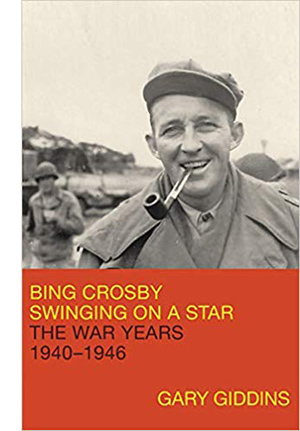 Reinventing, alas, devotes no space to Going My Way (1944), but after reading Giddins’ fifty pages on the film’s production, with sharp excursions into McCarey’s working methods and the tug-of-war about billing in the credits, I wish I had. It’s of course an extraordinary movie, loosely plotted and irresistible in its gentle momentum.
Reinventing, alas, devotes no space to Going My Way (1944), but after reading Giddins’ fifty pages on the film’s production, with sharp excursions into McCarey’s working methods and the tug-of-war about billing in the credits, I wish I had. It’s of course an extraordinary movie, loosely plotted and irresistible in its gentle momentum.
McCarey sold Crosby on the part as if he were peddling a modern High Concept project: “You’re going to play a hep priest.” Giddins carefully traces how the film took the country by storm and led to Crosby’s new, extraordinarily powerful contract with Paramount.
Bing enters my book in Chapter 11, as partner to Bob Hope in the zany Road films. These, along with other Hope vehicles, exemplify for me the acute movie-consciousness we find throughout the 1940s. Of course silent films and early talkies were often set among moviemakers (one of my favorites is Boy Meets Girl, 1938). But the theme shifted into higher gear in the 1940s and early 1950s, when we got films that exhumed Hollywood’s history (The Perils of Pauline, 1947; Singin’ in the Rain, 1952) and comic films that made fun of cinematic conventions. The latter is most wildly illustrated in Hellzapoppin’ (1941), but we get comparable cinematic in-jokes in the Road movies.
Giddins leads us behind the scenes, showing how the Road scripts, tentatively approved by the Breen Office, would get pulled apart during shooting and naughty bits of impromptu got shoved in in.
The writers aimed not only to make scripts funny but also to bamboozle censors. As Bing and Bob crisscrossed the set between takes, like fighters going to their corners, they would receive whispered zingers from personal gagmen, each star looking to unbalance the other; the constant comic rigor roused players and crew. Breen had no knowledge of the ad libs or how scenes would play.
Giddins is constantly throwing crosslights on these films. He shows, for instance, that the “high-velocity raillery” of The Road to Zanzibar (1941) owes something to producer Paul Jones, who had worked on Preston Sturges’ comedies. “The pace of the dialogue between crooner and comedian is impeccable, unforced, and funnier than the actual lines.”
To greater or lesser degree Giddins plumbs all the fourteen films Crosby made in these years, weaving them into the spectacular radio, touring, and recording career of one of the most popular stars in American entertainment. There’s plenty of sadness to go around too.
I could go on and on, as you know. After I finished the book I discovered George S. Kaufman’s 1945 play Hollywood Pinafore; or, The Lad Who Loved a Salary. It uses Arthur Sullivan’s score for H.M.S. Pinafore to mock the movie capital. Here’s a sample featuring the gossip columnist Louhedda:
Somehow all the weekly checks/definitely hinge on sex./ One man fills another’s shoes./Hard to tell whose baby’s whose./ Many autographs annoy/ Ella Raines and Myrna Loy./Goldwyn claims that all our ills/ Can be traced to double bills.
Et cetera. A bit labored, but cute.
Next time: Reinventing Hollywood and Happy Death Day 2U.
Thanks to Tom Gunning, Dan Morgan, Ally Nadia Field, Jim Lastra, Richard Neer, Jim Chandler, Mike Phillips, and Gary Kafer, as well as those who attended my lectures at the University of Chicago in January.
The following errors are in the hardcover version of Reinventing Hollywood but are corrected in the paperback.
p. 9: 12 lines from bottom: “had became” should be “had become”. Yow.
p. 93: Last sentence of second full paragraph: “The Killers (1956)” should be “The Killing (1956)”. What a brain fart. Elsewhere on this site I discuss Kubrick’s heist film at some length.
p. 169: last two lines of second full paragraph: Weekend at the Waldorf should be Week-End at the Waldorf.
p. 334: first sentence of third full paragraph: “over two hours” should be “about one hundred minutes.” Sad!
We couldn’t correct this slip, though: p. 524: two endnotes, nos. 30 and 33 citing “New Trend in the Horror Pix” should cite it as “New Trend in Horror Pix.”
Whenever I find slips like these, I take comfort in this remark by Stephen Sondheim:
Having spent decades of proofing both music and lyrics, I now surrender to the inevitability that no matter how many times you reread what you’ve written, you fail to spot all the typos and oversights.
Sondheim adds, a little snidely, “As do your editors,” but that’s a bridge too far for me. Instead I thank the blameless Rodney Powell, Melinda Kennedy, Kelly Finefrock-Creed, Maggie Hivnor-Labarbera, and Garrett P. Kiely at the University of Chicago Press for all their help in shepherding Reinventing Hollywood into print.
UChi marketing guru Levi Stahl tweets: David Bordwell stops by the office but refuses to pose with his own book unless you also let him include Richard Stark’s Parker novels in the picture. It’s as close as I’ll get to greatness.
Oscar’s siren song: The return: A guest post by Jeff Smith
A Star Is Born.
As you probably know, Jeff Smith has been our collaborator on Film Art: An Introduction and our Criterion Channel series “Observations on Film Art.” For the last few years (here and here and here), Jeff has offered his thoughts on the Academy’s music nominees. This time around, he concentrates on the songs.
Here’s a brief preview of the Best Original Song category in this year’s Academy Awards. I also include a prediction for this year’s winner. Of course, I’d be the first to admit I don’t even win my own Oscar pool. So you’ll want to take that into account before making any wagers.
A good old-fashioned tune
Mary Poppins.
The Academy has a long history of nominating songs from live action and animated musicals. This year is no exception.
“The Place Where Lost Things Go” from Mary Poppins Returns fits that bill, giving Disney a third straight nomination in this category. (“Remember Me” from Coco and “How Far You’ll Go” from Moana are the others.) Like the Sherman Brothers, who wrote songs for the original Mary Poppins, Marc Shaiman and Scott Wittman derived inspiration from British Music Hall.
In fact, although actor Lin-Manuel Miranda insisted that he didn’t want his character to sound like Hamilton, Shaiman and Wittman wrote a patter section of “A Cover is Not a Book” for him, enabling Miranda to show off his unique skill set. With its tricky wordplay and fast pace, the classic patter song is a forerunner of the rhymes spat by rap and hip-hop artists. As Shaiman noted, “So we got very lucky there because we didn’t want to feel like we were pandering to the audience, to supply Lin with rap that would seem anachronistic.”
“The Place Where Lost Things Go” sits on the opposite side of the musical spectrum as a soft, mid-tempo ballad scored for strings and winds. Fans of the original Mary Poppins will note that it bears more than a faint resemblance to “Stay Awake.” Both songs are sung to the Banks children at bedtime in an effort to inveigle them to sleep. Whereas “Stay Awake” shows the über-Nanny using reverse psychology, “The Place Where the Lost Things Go” is a paean to memory, loss, and grief. The children’s mother has recently died and they further risk losing their beloved house. Mary Poppins reassures the children that they will be reunited one day with all their loved ones and that, in the meantime, their mother will forever have a place in their hearts.
The number is beautifully sung by Emily Blunt and it captures the sense of melancholy that gives Mary Poppins Returns its emotional heft. Still, it seems like a long-shot to take home the award. I admire Marc Shaiman’s work. He has written some absolutely iconic scores in the past, like The American President. And I’d love to see him recognized this Sunday, even if it is just for his phenomenal work on South Park: Bigger, Longer, and Uncut. But I fear that an Oscar statuette with his name engraved upon it is also in the place where the lost things go.
When corn meets pone
The Ballad of Buster Scruggs.
The second nominee is David Rawlings and Gillian Welch’s “When a Cowboy Trades His Spurs for Wings.” It appears in the comically violent opening story of the Coen Brothers’ The Ballad of Buster Scruggs. It is sung as a duet by the titular character and the Kid, a mysterious gunslinger dressed in black. Buster has just been shot dead in a duel. In the song, the Kid imparts some lessons learned from his short, rugged life as a cowboy with Buster chiming in to provide harmony. Kid’s grimly acknowledges that he will suffer the same fate as Buster. It is just a matter of time.
Rawlings and Welch are long-time collaborators, having worked together on the former’s debut album. Rawlings has also produced albums by Welch and by Willie Watson, who plays the Kid. Adding to the sense of family reunion is the fact that Welch provided the voice of one of the Sirens in O Brother Where Art Thou? Among those enchanted by the Sirens? You guessed it – Tim Blake Nelson, who plays Buster.
In an interview in Variety, Welch describes the absurdity of the original pitch the Coens made to her and Rawlings:
It was a pretty straightforward thing: “Well, we need a song for when two singing cowboys gun it out, and then they have to do a duet with one of ‘em dead. You think you can do that?” “Yeah, I think we can do that,” she laughs.
In crafting the song, Rawlings and Welch pull off a rather neat trick. They’ve created something evocative of the “singing cowboy” films that inspired the first segment of The Ballad of Buster Scruggs. Yet is also connects with a larger tradition of mournful ballads that are part of folk and country music history. A lilting Texas waltz, the number is sparsely orchestrated, relying largely on guitar, harmonica, and vocals. The lyrics also make reference to a “bindling sheet.” As Welch noted, the word “bindling” was something she and Rawlings made up as a gesture toward the Coens’ fondness for anachronistic language. Yet it also works as a clever allusion to the “white linen” that is wrapped around a dying cowboy’s body in “Streets of Laredo.”
As was the case with Mary Poppins Returns, this song perfectly blends music and narrative, beautifully capturing the darkly humorous sensibility characterizing the Coens’ career. The lyrics are solemn, but Tim Blake Nelson’s yodeling lightens the tone to keep it from seeming maudlin. If I had a vote to cast, this is where I’d put it. Yet my gut tells me that the Academy’s beacon will shine on one of the other nominees.
A song for one of the Supremes
Notorious RBG: The Life and Times of Ruth Bader Ginsburg.
The third nominee, “I’ll Fight,” was written by Diane Warren, a longtime Academy favorite. The song represents Warren’s tenth nomination, but she has never taken home top honors. This year, in an ironic twist, she may lose out to former co-writer Lady Gaga. (The two were nominated for “Til It Happens to You” in The Hunting Ground.) Warren admits that “I’ll Fight” is another of her “call to arms” songs as she has turned more of her energies toward films that support social causes.
One can easily make a solid prima facie case for “I’ll Fight” as the song to beat. It features a strong, soaring vocal performance by Jennifer Hudson, a previous Oscar winner for Dreamgirls.
Warren’s melody and lyric capture the inspirational vibe that is found in several previous winners, most recently “Glory” from Selma. And, of course, Warren herself seems long overdue.
Even so, “I’ll Fight” has a number of things working against it. It is featured in a documentary, and documentaries usually don’t get the exposure of more mainstream releases. It appears over The RBG’s closing credits, which mostly restricts the song to a summative function. And, unlike “All the Stars” and “Shallow,” the song failed to chart, an indication that it didn’t get much exposure in the music marketplace. I feel confident that Warren’s opportunity to make an acceptance speech will come someday. But on Oscar night, she’ll once again be the “bridesmaid” rather than the “bride.”
The battle of the titans
Black Panther.
For me, the race comes down to the remaining two nominees: “All the Stars” from Black Panther and “Shallow” from A Star is Born. Both tracks have gotten extraordinary exposure outside the films in which they appeared. The former was a chart hit in 25 countries, garnering steady radio airplay and thousands of streams and downloads in the process. The latter arguably did even better, charting in 40 countries, selling nearly 600,000 downloads and accruing almost 150 million streams. Both songs are fueled by star power: hip-hop sensation Kendrick Lamar for “All the Stars” and pop diva Lady Gaga for “Shallow.”
Lamar has just the right profile to woo Academy voters, even those in the music branch for whom “big beatz” and “flow” seem like foreign concepts. He has won thirteen Grammy Awards as well as the 2018 Pulitzer Prize for Music, becoming the first artist to do so from outside the domains of classical and jazz music. Billboard even compared Lamar to Shakespeare.
Although some music critics argue that “All the Stars” is not entirely typical of Lamar’s and SZA’s respective styles, it does fit beautifully with the overall vibe of Ryan Coogler’s pathbreaking film. The song begins with loping rhythms, electronic textures, and auto-tuned vocals. When Lamar drops the beat in the chorus, “All the Stars” gains intensity thanks to the layering of additional synthesizers and SZA’s melismatic topline.
The overall effect is one that neatly draws together Black Panther’s principal settings, being equal parts Wakanda and Oakland. The tension in the lyrics between the sung choruses and Lamar’s linguistic turns also restages the film’s central conflict: Prince T’Challah’s policy of peaceful co-existence vs. Killmonger’s thirst for violent world revolution. Appearing over the end credits, the number also works brilliantly with the shifting lines, shapes, and textures of the sequence’s graceful animation.
Lady Gaga, of course, supplies “Shallow” with its vocal fireworks. But she shares her nomination with three other collaborators, all of whom cut pretty large figures in the world of popular music.
Chief among them is superproducer Mark Ronson, who twirled the knobs on Gaga’s fifth album, Joanne in 2016. Ronson is perhaps best known for his smash hit, “Uptown Funk.” Yet, Ronson had already won three Grammy’s for his production of Amy Winehouse’s Back to Black long before he gave us his Bruno Mars earworm. Besides his production work for Gaga, Winehouse, and Mars, Ronson has collaborated with a “who’s who” of current stars and pop music legends: Adele, Lily Allen, Miley Cyrus, Kaiser Chiefs, Chance the Rapper, Janelle Monae, Duran Duran, Nile Rodgers, and Paul McCartney.
One of Ronson’s other songwriting partners, Anthony Rossomondo, shares the nomination for “Shallow.” Rossomondo is a guitarist and trumpet player who was a founding member of Dirty Pretty Things and toured with the Libertines as Pete Doherty’s replacement. Fans of British television might also remember Rossomondo as Pete Neon in The Mighty Boosh, the surrealist comedy series about a pair of failed musicians working in an alien shaman’s magic shop.
Rounding out the quartet of songwriters is Andrew Wyatt, still another songwriting partner of both Ronson and Gaga, who also penned tunes for Mars, Lil’ Wayne, Beck, Florence + the Machine, and former Oasis bad boy, Liam Gallagher. Wyatt also has previous experience writing for film. He composed four songs for the Hugh Grant/Drew Barrymore romantic comedy, Music and Lyrics, including the wonderful pastiche of eighties New Wave, “PoP! Goes My Heart.”
With so much musical talent on board, it is hard to see how “Shallow” could miss. Yet the song’s many virtues are enhanced by its perfect placement in the story. It was a lot to expect that one song could deliver something that a) pays off the romantic sparks of Ally and Jackson’s initial flirtation; b) signifies Ally’s leap of faith as she returns to the stage to complete Jackson’s arrangement of her song; and c) convince the audience that Ally could legitimately be the proverbial overnight sensation of the film’s title. “Shallow” delivers on all that and more.
The song begins with Jackson singing, “Tell me something, girl.” The first verse is sparely arranged for just voice and acoustic guitar. Jackson essentially baits Ally into claiming a spotlight he believes is rightfully hers. When Ally comes on stage, she begins the second verse in the lower part of her vocal register, adding a husky sensuality that captures the slow-burn of the couple’s simmering passions. Piano, violin, and pedal steel guitar slightly thicken the arrangement while maintaining the relatively soft dynamic level. An octave leap leads into the chorus, which Ally belts out with newfound confidence.
The lyrics serve as a metaphor for the character’s personal journey, her willingness to take the emotional and professional risks that Jackson had encouraged. This is Ally’s moment of self-realization. Yet it also foreshadows the relationship’s failure by previewing a future in which her stardom will overtake his.
This is followed by Jackson and Ally finally harmonizing together on the phrase, “In the shallow, the sha-ha-low.” Their voices blend, suggesting the consummation of their romantic connection onstage, if not yet in bed. Ally follows with a kind of vocal cadenza. No longer bound by lyrics, she sets free the “yargh” in her voice that rock critic Greil Marcus famously ascribed to Van Morrison’s Irish soul.
The addition of drums and bass enhance the big crescendo that leads into the final chorus. Jackson joins Ally at her microphone and the two finish the song with a final duet. The song is in G major, but ends on an E minor chord, another subtle hint of the sadness that ultimately consumes couple’s relationship.
As an Oscar nominee, “Shallow” has a lot to offer. It is a duet between a major movie star and a major star of the recording industry. It not only pays off a previous dangling cause, but also foreshadows later plot developments. Best of all, it takes the audience on an emotional journey that symbolizes the characters’ story arcs in microcosm. If the snatch of “Shallow” heard in the A Star is Born trailer proved surprisingly meme-worthy, the full performance of it in the film was indelible. Moreover, in a cheeky bit of self-mythologization, it invites viewers to consider “Joanne,” the flesh-and-blood being that sits just behind the Gaga mask.
Prediction: “Shallow”
I likely tipped my hand earlier, but I fully expect Lady Gaga and company to add Oscar to the Grammy and Golden Globe they’ve already won. If that happens, I’ll be content with the result, even if the memory of Tim Blake Nelson and Willie Watson’s duet tickles me every time I think of it. I’ve enjoyed Mark Ronson and Lady Gaga’s music for more than a decade. And if nothing else, an Oscar for Andrew Wyatt will balance the scales of justice. Back in 2008, I felt Wyatt was robbed when he failed to secure a nomination for a song Billboard called “the greatest fake 80s song of all time.” Well, if I see Wyatt clutching an Oscar come Sunday, you’ll hear a little PoP! go in my heart.
For an alternate take on this year’s music nominees, a real pop star from the eighties, Thomas Dolby, offers his perspective here. A report on a panel discussion at the Los Angeles Film School featuring several of the nominees can be found here.
Marc Shaiman and Scott Wittman talk about their work on Mary Poppins Returns here and here.
Gillian Welch discusses working with the Coen Brothers on The Ballad of Buster Scruggs here and here.
Diane Warren offers her perspective on writing “empowerment anthems” here and here. A deep dive into Warren’s career can be found on a Hollywood Reporter podcast featuring the 10-time Oscar nominee.
Finally, much ink has been spilled about the process of writing “Shallow” for A Star is Born. You can read more here and here and here and here.
Jeff Smith has provided us many guest blogs related to film music, most recently his discussion of the score for True Stories.
Music and Lyrics (2007).
3D in 2019: RealDvided?
Kristin here:
From August of 2009 to April of 2012, David and I (mostly I) posted a series of entries on the spread of 3D film production and exhibition. The series kicked off with my provocatively titled, “Has 3-D already failed?”. It had a lot of background facts and figures, but the main point was to express skepticism about the extravagant claims that were being made by some in the industry who predicted that eventually most or even all films would be released in 3D. I opined that 3D would probably remain confined to certain genres, mainly animated films and big action pictures. At the time, Julie & Julia was my example of the type of film that would never be made in 3D. Today it could be Can You Ever Forgive Me?
I followed up four times during 2011, as 3D continued to spread. In January I posted “Has 3D already failed? The sequel: RealDlighted.” Hollywood was just coming off the year that 3D admissions as a percentage of total box-office peaked at 21%, to a considerable extent thanks to Toy Story 3. Of the top eleven grossers, seven were in 3D. 3D TVs had become a significant force in the electronics market that year as well, though sales were lower than predicted.
Conversion of screens overseas was also proceeding apace. That surge would eventually fuel the continued production of 3D films in the US, despite their decline in the domestic market.
Already, though, industry commentators were predicting that decline. I cite some of them and their arguments in this entry.
Our entry was followed later in January by the second part: “Has 3D already failed? The sequel: RealDsgusted.” I dealt with the backlash among audiences and critics, especially in the face of conversions of past films to 3D. Not being a fan of 3D, I pointed to the one film in that format that I looked forward to seeing: Herzog’s Cave of Forgotten Dreams (2010). It did not disappoint, and its tour of the Chauvet cave, not open to the public, struck me at the time as an ideal use for 3D. I still think so.
In July, in “Do not forget to return your 3D glasses,” I examined the fact that 3D films’ shares of total box-office takings were falling. It wasn’t by much, only from 21% in 2010 to 18% in 2011–but there were more 3D films released that year, and a lot more theaters were equipped by that time to show them.
On August 30, I ended my series with “As the summer winds down, is 3D doing the same?”
In April, 2012, David weight in on the roles played by James Cameron and other powerful directors in pushing digital projection and 3D, in his “It’s good to be King of the World.” That entry, extended and updated, became a chapter in his e-book, Pandora’s Digital Box.
Our series got quite a bit of attention because Roger Ebert, a foe of 3D, cheerfully linked all of our entries.
As it turned out, our series appeared just after the technique had begun its slow drop in the percentage of total box-office receipts provided by 3D screenings.
Assuming the decline has continued, by 2018 that percentage might have been as low as half the high of 21% in 2010 (fueled primarily by Avatar, which was released on December 18, 2009). Will Cameron’s current big 3D project turn the tide? I’ll have a little to say on that at the end.
It has its moments
Ironically, at about the same time that our series closed, we became increasingly interested in the format. Not that we had completely rejected it to begin with. There had been some excellent animated films made by Pixar, Laika, and Disney. The occasional auteur dabbled in the format, as when Scorsese made Hugo (2011). This is a far cry, though, from believing or hoping that 3D would become universally used. Again, who would want to see If Beale Street Could Talk or Vice in 3D?
But the technology improved, and the films got better-looking. More auteurs utilized 3D. There was Cuarón’s Gravity (2013), perhaps the first film in which the 3D effects were utterly convincing. That was partly because so many shots were largely or entirely digitally created and partly because of innovative lighting technology. I still think it’s the only film I’ve seen that is dramatically better in 3D than flat. In 2016, Spielberg made the underappreciated The BFG. At the opposite end of the spectrum, Jean-Luc Godard proved that 3D technology could be simple indeed and still create a masterpiece like Adieu au langage (2014; see here and here). That and Gravity are the only films that I think really must be seen in 3D.
Older 3D films also got a new lease on life through home video. It was the 2012 release of Dial M for Murder on 3D Blu-ray that spurred us to invest in a 3D television. (David saw the screening at the Toronto International Film Festival and wrote about it.)
Interestingly, 3D televisions provide the first method which allows someone analyzing a 3D film to watch it on a personal viewer rather than needing it professionally projected on a screen. You can freeze the frame, and the 3D image hovers before you.
Unfortunately 3D lasted on television for a very short time. By 2012, DirectTV dropped it, and sports, the great hope for 3D television, failed to sustain the format as ESPN stopped showing 3D in 2013. From 2014 to 2017, the major manufacturers of 3D TVs ceased production of them. We shall simply have to nurse ours along or somehow buy a backup machine before it’s too late. Fortunately most 3D Blu-ray discs have been sold as a set with standard Blu-ray copies of the same film, so we can go on watching Moana and Kubo and the Two Strings and others once the set ceases to function. (Robert Silva offers a good rundown on the history of 3D TV, including the reasons for its failure. As he points out, home-theater video projectors with 3D capacity are still available.)
Blink and it’s gone
These days, it seems that unless you live in a large city, if you don’t catch a 3D screening early a film’s run, it will later only be showing flat.
I first noticed this diminution in the number of 3D screenings last summer. Incredibles 2 was showing at our local multiplex, Marcus Point Cinema, part of the Marcus chain of nearly 700 Midwestern theatres, and I wanted to see it in 3D. Checking the theater’s schedule, I was startled to discover that the 3D version was playing only once a day, at 8am. There were 17 showings in 2D. The film had opened on June 15 and thus had been out a little over two weeks.
David and I usually wait for a few weeks to see a popular film so that the crowds will die down. I expected that there would be few people at an 8 am show, so I set my alarm and set out early the next morning for Point Cinema. I purchased my ticket, and as I was moving away from the ticket desk, I heard the woman behind me purchase tickets to Incredibles 2 for herself and her two children. She bought them for the 8:10 am screening in 2D. The children were not too young to cope with 3D glasses, and the family was there early enough to attend the 8 am screening with me. Whether through a wish to save money or simply by preference, they had chosen to see the film in 2D. Indeed, I had the pleasure of a completely private screening.
Another of 2018’s big 3D films was also playing, as the schedule above shows. Jurassic World: Fallen Kingdom (which I didn’t see) had two 3D screenings per day, against sixteen flat ones. It is notable that five of those were on the “Ultrascreen.” This may suggest that large-screen showings with elaborate sound systems, including IMAX, are more attractive to audiences than 3D, even when these large-screen showing also involve an upcharge. More about that later.
I wondered if this imbalance between 3D and 2D screenings was part of a larger pattern, so I have occasionally checked schedules for other 3D films. Also, might Marcus be limiting the number of 3D screenings so severely, or were other theaters doing the same? On August 1 I looked up the schedule for Mission Impossible: Fallout, showing at two local multiplexes: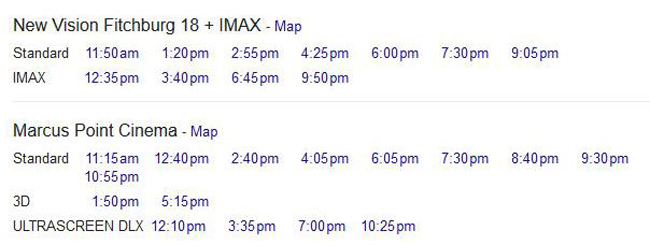
Point Cinema was showing the film twice in 3D, four times flat on its Ultrascreen, and nine times “standard,” as 2D on an ordinary screen is now known. Its rival theater, New Vision Fitchburg 18 + Imax, had no 3D screenings at all; as the possessor of our only IMAX screen, it had four flat screenings and seven standard ones.
On September 17, I found this schedule for another popular animated film:
Again we see the considerable imbalance, with two 3D screenings versus fourteen in 2D.
Might this imbalance result from the fact that I was waiting a while into the run to check? I looked at Ralph Breaks the Internet for November 26, 2018, the Monday after its opening on Wednesday, November 21:
The same pattern holds even during the first week of the film’s run, in both theaters. In this case, however, the 3D screenings seem to have ended sooner than we expected. We went to Ralph on December 7, and there was no 3D showing available, so we saw it in 2D. The same ended up being the case with Spiderman: Into the Spider-Verse, which apparently had no 3D screenings after its first or second week. That’s a film we have been told would distinctly benefit from being seen in 3D, but we missed our chance. So far it’s not even clear whether the film will be released in 3D for home video.
I decided to try a similar exercise with a much larger city: Chicago. Of the theaters selling tickets on Fandango for Saturday, January 26, 375 screenings were of 2D versions, and eight of 3D films, all of the latter at AMC theaters. One of the latter is of A Beautiful Planet, an Imax documentary. Five of the 3D screenings were of Aquaman and two of Spiderman: Into the Spider-Verse.
I realize that awards season is not the ideal time of year to be looking at statistics of 3D films. Many of the films currently playing in cinemas have Oscar and other nominations, and have been held over to play only a few times a day to take advantage of that fact. On the other hand, there are some films, including Oscar nominees, that could plausibly have been made in 3D a few years ago and were not. These notably include Mary Poppins Returns, Glass, Bumblebee, and First Man. (M. Night Shyamalan has said he would never make a film in 3D, but Glass is the sort of film that another director might have made in that format.) I’ll try the same exercise during the summer movie season and see what the balance is. I’m sure there will be more 3D screenings proportionately than there are now–but probably not as many as in 3D’s heyday of 2010 to 2013.
Even an event film that depends heavily on its flashy technical aspects, Peter Jackson’s restored, colorized, 3D-ized, sonorized documentary, They Shall Not Grow Old (2018), was shown here in Madison more often in 2D. It played on two days in late December. On the first day, 3D was available, but we saw it on the second and had to settle for 2D. It was brought back again recently for a short run, and we saw it again, this time at the single daily 3D matinee screening available. There were five 2D shows on the Ultrascreen.
This time Marcus’ other local multiplex didn’t show it in 3D at all.
We thought that seeing They Shall Not Grow Old in 3D was interesting and worthwhile. Still, we had thought it very effective without the 3D. The restoration, color, and sound were the most remarkable parts of Jackson’s transformation of the old footage.
All of these schedules are for 3D films that had been running for a while. I also, however, checked the opening Friday, February 8, for The Lego Movie 2: The Second Part. (It opened Thursday, February 7, but Friday was the first day with a full schedule.)
Four theaters, including three multiplexes, were playing the film that day. There were a total of 40 screenings, 16 of them standard, 18 in IMAX or Ultrascreen DLX auditoriums, and six in 3D. None of the latter were on large-format screens. As in earlier cases, the Marcus Palace Cinema had no 3D screenings, even for the opening weekend; it does have 3D capacity. It has two Ultrascreen DLX auditoriums, which the managers seem to favor over 3D. Flix Brewhouse Madison does not have 3D facilities, but as its name implies, one can consume sandwiches, beer, and so on while viewing films.
PLF vs 3D
This reluctance on the part of theaters to devote their screens and time-slots to 3D reflects the general decline in the format. According to Variety, ever since Avatar (2009) pushed cinema owners to invest in 3D equipment (and in the case of those who hadn’t converted yet, to switch to digital projection), 3D has declined. From $2.2 billion in grosses in 2010, fueled largely by Cameron’s film, the figure had shrunk to $1.3 billion in 2017. That year only 44 films were released in 3D, dropping from 52 in 2016.
We’re all familiar with the reasons for this, which we discussed in our series linked above and which continue to be chewed over in the press. People don’t feel the upcharge is worth it. Small children can’t keep the glasses on. Some moviegoers get headaches from the glasses. The projection system and the glasses often create a dimmer image. Virtually all 3D live-action films have some shots converted to 3D in post-production. The post-production conversion process has improved, but some early shoddy post-production conversions gave people the idea that only native 3D films are worth watching.
Theater owners and managers have their own set of reasons for not wanting to show 3D. We haven’t been able to find out the range of terms distributors set for theaters renting a film. Are 3D screenings required for any film offering that option? Are there minimum numbers of screening? Must the screenings be in auditoriums of a minimum size? How long does the 3D run have to be? Still, I have gleaned a bit of information from people involved in exhibition.
One employee of a multiplex told us that a film released in a 3D format had to be given some 3D screenings at the opening week of the run. The exhibitor could then continue the 3D shows if the box-office receipts warranted it. This makes sense, as the distributor is getting a cut of the takings. Given 3D’s decline in popularity, this pretty much explains the pattern of the small numbers of screenings reflected in the schedules illustrated above.
The owner of one Midwestern small-town theater pointed out to us that the 3D upcharge in itself hurts the theaters. He declined to convert to 3D back when distributors were pushing theaters to do so. At the time, he recalls that about fifty cents of the proposed $2 upcharge went to the 3D firm and the distributor got a percentage of the remainder. Moreover, as he put it, “For a family of four that’s $8 less for vending – that’s my reasoning.” As we know, movie theaters typically depend on their customers buying expensive treats at the concession stand (and increasingly on meals, whether consumed in their theater seats or at a restaurant positioned in the lobby) to make a profit.
3D also is losing out to an attraction that moviegoers are proving more willing to pay extra for: PLF or Premium Large Format auditoriums. The most high-profile of these is IMAX, which starting out in the 1970s as a largely museum-based attraction showing its own short documentaries. It branched out into occasionally showing studio feature films, starting with Disney’s Fantasia 2000 (2000) and continuing with such event films as the last five Harry Potter installments. It was when IMAX films went from being shown on 70mm film to a digital format (introduced in 2008) that it really took off, since existing multiplexes could convert an auditorium to an IMAX venue. From 299 screens worldwide in 2007, IMAX expanded to 1302 by September, 2017. Of those, 1203 were in multiplexes.
For much of this time IMAX screenings were often in 3D. With the waning popularity of that format, however, in July, 2018, IMAX announced that it was cutting back on 3D. The success of Dunkirk in 2D IMAX was cited as proof that people would accept even a period war film not involving Americans if shown in the large format and flat. The announcement specified that IMAX screenings of the forthcoming Blade Runner 2049 would be only in 2D. The fact that Christopher Nolan had shot much of Dunkirk using an IMAX film camera became a publicity point for the film. Similarly, the fact that Cuarón shot Roma in digital large-format featured in popular coverage (the camera was an Alexa65). The irony that the film would mainly be seen on TV screens was not lost on commentators, but at least it received a limited theatrical release, including 70mm screenings. Large, sharp, flat images were winning out over 3D.
The Ultrascreen DLX mentioned above in some of the Marcus schedules is a somewhat smaller version of IMAX combined with luxurious surroundings. The chain’s website provides details.
The UltraScreen DLX® concept features three important S’s – screen, seating and sound. A massive screen size coupled with HEATED DreamLounger℠ leather recliners provide maximum comfort, including a spacious seven feet of legroom between the rows of seats. Add immersive, multidimensional sound for a lifelike experience that makes guests feel part of the action. Speakers are located in the front, back, sides and ceiling to bring even more dimension to the audio of a film.
The system of speakers described is an Atmos installation.
Theater chains typically brand their own PLF installations. Ultrascreen DLX is Marcus’ version, while the B&B chain (the country’s seventh largest, operating mainly in the plains states) has its B&B Grand Screens (see bottom). The first was introduced in 2010 in St. Louis. Some chains mix IMAX with their own brand, depending on the local market. Regal, for example, has 87 IMAX houses and 89 with its proprietary RPX screens. (For a detailed history of the spread of PLF installations to 2016, see Daniel Loria’s “Large Screens, Premium Experience.”)
In many cases, these large-screen auditoriums include other “premium” aspects, such as the big reclining seats, wide gaps between rows, and elaborate sound systems. As with 3D, the ticket price involves an upcharge, but since no fee goes to the 3D company for the glasses and other expenses, the theater owner keeps more of that extra money.
Blame China
It’s common to point out that China, now the world’s second largest movie-exhibition market and soon to become the first, loves 3D. The Chinese are building new theaters at a fast clip, and a high proportion of the new screens have digital 3D capacity. In fact, in 2016, fully 78% of screens in the Asia-Pacific region could show 3D, an astonishingly high proportion considering that in the US the figure was half that, at 39% (according to IHS Markit). And that 78% was a share of far more theaters, 46,949 3D-capable theaters in the region versus 16,745 in the US. Undoubtedly China’s share was larger than its neighbors in Eastern Asia and the Pacific Rim. Other areas of the world also had higher proportions of 3D screens than the US, though not by nearly as much. Europe, the Middle East, and Africa together had 45% 3D screens, and Latin America 43%.
Thus the common wisdom is that Hollywood continues to make 3D films to a large extent to cater to Chinese enthusiasm for the format. Indeed, some films that are released only in 2D in the States are shown in 3D in China, including 2012 (2009), Looper (2012), Iron Man 3 (2013), Lucy (2014), Transcendence (2014), and Jason Bourne (2016). The latter ended up nauseating quite a few Chinese viewers, given its “run-and-gun” style compounded by the 3D.
Naturally Hollywood wants to cater to this giant market, even though the percentages of the ticket receipts returned to the American studios by Chinese distributors are considerably lower than in the US and other markets.
So why show 3D films in the US at all? Presumably there remains enough of a market for them that studios don’t want to risk leaving money on the table. Since they’ve laid out the extra money to make a film in 3D, they might as well show it. There are presumably some people, especially teenagers, who are much more likely to see a film if it’s in 3D.
The question is, will the slow decline of 3D, with fewer films made each year and a lower share of the box-office contributed by them, eventually lead to the complete demise of 3D? Will the failure of 3D TV mean that fewer and fewer 3D films will be released for home-video in 3D? Already this has happened to some extent.
In 2014 for the first time Disney released one of its successful 3D animated films, Frozen, only on standard DVD and Blu-ray. It has continued this policy. In England, though, some Disney films are still released in 3D Blu-ray. Remarkably, amazon.com offers the imported region-free Irish 3D Blu-ray, Blu-ray, and DVD combo of Moana at a bargain price, and it’s not from a third-party seller. We may be out of luck with Ralph Breaks the Internet, since Amazon UK has announced a Blu-ray-DVD set, with no 3D option.
I for one would regret the total demise of 3D. There are relatively few films that I strongly prefer to see in their 3D versions, but it would be a pity if filmmakers did not have the option of making a film like Gravity or Cave of Forgotten Ancestors or Moana in 3D.
It may happen, though. In mid-January an online post in Chinese speculated that people there were becoming less obsessed with 3D. (The original Chinese piece is here, with a brief summary in English here.) How long might take for Chinese moviegoers’ enthusiasm to cool to the extent it has in the USA? Perhaps within a few years China and other overseas markets will no longer provide an adequate support for 3D.
The return of James Cameron
While the world awaits the four threatened sequels to Avatar (currently announced for 2020, 2021, 2024, 2025), we have another another Cameron project to re-excite us about 3D. Originally Cameron had planned to direct Alita: Battle Angel himself, but given the burden of responsibility for all those sequels, he turned those duties over to another advocate of 3D, Robert Rodriguez, with Cameron producing and co-writing. (Sin City is much admired by 3D fans.)
I post this on the second of two days featuring special evening screenings of Alita only in 3D, even as it shows. This has literally been publicized as an event movie, an “Early 3D Fan Event.” (See top.) Only one of our local multiplexes is showing this early screening. Interestingly, it’s the Marcus Palace, which seemed to avoid 3D for the earlier films for which I checked. This being a special fan event, modest swag is involved.
Cameron must be disappointed that 3D has not spread to the point where all screenings of Alita could be in 3D. The existence of this “3D fan event” basically acknowledges that there is a core audience for 3D and another audience, probably much larger, who usually, if not always, would prefer standard screenings. The 3D fans presumably are inclined to come to the film when it first opens, and this event caters to that habit–and ideally generates favorable word-of-mouth for the 3D version.
The film has had a mixed reception from critics, with a 60% rating on Rotten Tomatoes. Nearly all the reviews I have read, even favorable ones, fault the script but praise the visual effects (by Weta Digital). Most do not mention the 3D. One enthusiastic reviewer, Molly Freeman on Screen Rant, did mention and laud the 3D, writing, “However, the true star of the movie isn’t the writing or any of the performances, it’s the visuals. To the filmmakers’ credit, the visuals are absolutely stunning and if moviegoers have to choose only one 2019 release to see in IMAX 3D, Alita: Battle Angel is it.” This is a good news/bad news comment. On the one hand, Cameron would be glad to see the 3D in this film recommended so highly. On the other, it does suggest what is happening in reality: that many moviegoers are avoiding 3D unless it has the sort of event cachet that has been created around this particular film. And only time will tell whether audiences will take this advice, at least after the first week or two. Initial reports are not sanguine.
Early on in the run, the Alita will be showing on many screens, PFLs or not. The opening weekend, February 15-17, has this set of offerings in Madison:
Setting aside the IMAX screenings, New Vision has opted for one fewer 3D showings than standard ones. The two Marcus multiplexes have no 3D screenings apart from on their Ultrascreens. The same pattern carries into the following weekdays, except that New Vision has no morning matinees. (The Marcus cinemas, as we’ve seen, starts some screenings as early as 8 am every day.) Marcus management seems to assume that 3D is less appealing on a regular screen than a PLF one, despite the double upcharge. This upcharge, by the way, is significant, especially for a family. An adult ticket for a 2D screening at New Vision costs $11.40, a 3D ticket $15.10, and a 3D IMAX ticket $17.21. That’s just about 50% more for the highest ticket than the lowest.
A news item about Alita reveals one more reason why theater managers might not be overly keen on showing 3D. We all know that 3D glasses are notorious for cutting down the brightness of the projected image. It turns out, however, that there’s much more to it than that. Projecting 3D is not simply a matter of slapping a different lens onto the projector and ingesting a DCP file into the projector, as a fascinating article on Rerelease News reveals. Theaters receive several DCP files, and which one they use depends on the sort of projection set-up they have. Given that projection is now done by people with minimal training, the wrong file sometimes is used. Cameron, Rodriguez, and Jon Landau (who also was a producer on the film) were clearly concerned about this and included a message to theaters playing Alita:
IMPORTANT 3D NOTE: The key to the 3D experience is the light. You have been provided with both a general release 4.5 FL 3D DCP and a premium 6 FL-XBrite 3D DCP. Projecting an XBrite 3D DCP at the standard 4.5 Foot Lamberts of light will result in a dark, hard-to-see presentation. It was especially color graded at 6 foot lamberts and must be run at 6 FL. Projected in this way, it will look amazing!
Conversely, if a general release 3D DCP is shown at 6 FL it will look overly bright. It must be run at 4.5 Foot Lamberts, and it will look terrific at that light level. Since you may have some auditoriums capable of running at 6 FL 3D with others that can only hit 4.5 FL 3D, please confirm that the correct DCP file is loaded in the appropriate theater and that each is run at its proper light level.
This will make a huge difference in the presentation and to audience enjoyment. Thanks so much from Robert Rodriguez, Jon Landau, and Jim Cameron.
I’m sure this is excellent advice, and I hope it is followed, especially at the Marcus Point multiplex near us. Still, I suspect not all theater managers enjoy being confronted with this sort of complexity.
The takeaway from all this is that I and I’m sure many others, were right in predicting that 3D would remain a niche within popular cinema as a whole, confined largely to animation and to fantasy and sci-fi films. More interesting, though, is the fact that PLF auditoriums have proven more popular as a reason to get off the couch and go to a theater, even if the comfort, spaciousness, mega-multi-track sound, and huge screens come at a higher ticket price.
Thanks to David Hancock of IHS Markit for his assistance over the years. Also, thanks to Steve Guttag and Russ Collins for information about 3D. For the story of how 3D became the Trojan Horse in the digital conversion of theatres, see Pandora’s Digital Box.
Thanks also to Jim Healy for some expert opinions and for pointing me to the Rerelease News piece.
PS [Added February 18, 2019] More evidence, for the opening weekend of How to Train Your Dragon: The Hidden World here in Madison:
[PPS March 6: Tomorrow will be the last 3D showing in Madison, at 5 pm at Marcus Point. After that it will shown only in standard or PLF.]
Love on your menu: CHUNGKING EXPRESS on the new Criterion Channel
DB here:
Signed up as a Charter Member of the relaunched Criterion Channel? Good. Now you can stream the Movie of the Week: Chungking Express, one of the favorite films of nearly everybody I know.
It’s streaming with Tony Rayns’ excellent commentary, personal reflections from Barry Jenkins, and an installment in our series Observations on Film Art. Just running the trailer will get you worked up.
If you haven’t signed on and you live in the US or Canada, you should get your free trial pronto. The 30-day trial period doesn’t even start till the official launch on 8 April. That’s two months off, meaning many more totally free, tightly curated Movies of the Week to come.
Wonder what next week’s feature will be? Me too. It will drop, as everybody but me now says, on Wednesday. And Chungking will vanish. But just for a while, until the full collection bursts on the world in April. Then you can run Chungking Express every day if you want. Not the worst plan I’ve heard.
Thanks as usual to all the Criterionistas, especially Peter Becker and Kim Hendrickson.
I wrote a personal note on Chungking Express when it first surfaced on the FilmStruck platform of the Criterion Channel.












